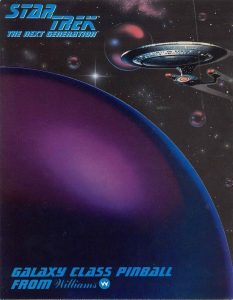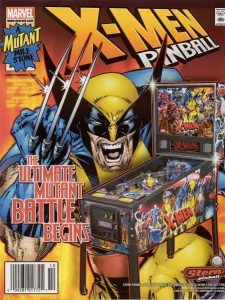From 1947 to 1967, wages doubled [1]. With this increase in wages, many teenagers found themselves playing pinball to spend their time and money [2]. During the Great Depression, children were more likely to graduate high school, because of the lack of work available for them [3]. By the time World War II ended in 1945, the participation of children and teenagers in the work force was limited. The “lack of productivity” resulted in teenagers forming “their own distinct forms of popular culture” [4]. The increase in wages as well as the increase of leisure time contributed to the increased popularity of pinball and the arcade scene, especially among teenagers.
Arcade

Music
While invented in America, the influence of the pinball has been far-reaching. In 1969, the Who, a British Rock band, released a single titled, “Pinball Wizard.” According to an interview given in 2004, Pete Townshend created the song because a music critic had not been as impressed with the Who’s current project, “Tommy” [9]. Townshend shared that when he sarcastically asked if a song about pinball would get a good review from the critic, the critic responded, “Of course I would. Anything with pinball in it is fantastic!” [10] “Pinball Wizard” ended up being the Who’s second most popular single in America, reaching no. 19 on Billboard’s Hot 100 [11]. The popularity of the song “Pinball Wizard” demonstrates that pinball was more than just a game to play at the arcade. Despite the joke around which the song had been written, the popularity of the song suggests that Americans had a fondness for the game and valued those that were skilled at playing.
Literature
Pinball has also found its way into literature. Many poems and short stories include characters playing pinball or make references to the game. One poem that stood out to us is titled, “God, Reagan, and the Cosmic Pinball Machine,” by Ann Struthers. Published in the Minnesota Review in 1988, the poem contains vivid imagery about playing pinball. The first ten lines are as follows:
I see a gang of boys at Maybee’s Drug Store surround
the pinball machine, watch one boy play,
intense, as if he believes
in its painted green surface;
he pats its rainbow-colored sides,
one of his knees braced against its long, straight leg.
Releases the plunger that beats the colored marble,
sends it careening around the knobs and breakers.
He knows how much he can lean on it
before TILT flashes [12]
Struthers’ first ten lines create a powerful mental image of playing pinball. The reader can almost sense the intense concentration of the boy as he plays. Alongside the powerful imagery that Struthers’ employs, her poem also offers some insight in to gender stereotypes about girls from that time period. Lines 17-19 demonstrate this.
The girls observe, giggle. They don’t waste their money
on pinball. They buy cherry cokes, lipstick, mascara,
movie magazines bulging with romance [13]
These three lines from Struthers’ poem demonstrate the gender stereotype that girls were not interested in pinball or arcade games. Instead, the girls merely liked to watch the boys play and giggle as they watched, spending their money on make-up and romance.
Pinball’s incorporation into literature demonstrates the lasting impact of pinball in American culture. It has its place in America’s past, a game to be looked back on with nostalgia.
Hollywood Franchises
For years, pinball machines have been decorated to represent various movies and television shows. This is especially true with the new pinball machines being created today. The use of Hollywood franchises to decorate the machines could have attracted players to the game as well provide advertising for the movies and television shows to increase sales and ratings. There is not much research available about the decorating of the pinball machines, but The Strong: National Museum of Play has several images of advertisements of pinball machines depicting various Hollywood Franchises.


Today
Unfortunately in today’s society, pinball is no longer as popular as it once was. The pinball industry took a severe hit upon the introduction of affordable console systems, like Xbox, which could be played at home [14]. Today, pinball has become a part of the past, a game that is looked back on with nostalgia. pinball machines have now become a collector’s item, just a simple search on Google will reveal how much many machines are worth today. One such search, conducted on March 29, 2017, under the term “pinball machine” reveals that some machines are being sold for thousands of dollars. Central Park Funland, a Family Fun Center located in Fredericksburg, Virginia, lists pinball amongst the classic games they offer [15]. Pinball has been regulated to the status of “classic” in this newer age of video games.
Pinball, however, has not entirely disappeared from the gaming world. Many games include mini-games within them where the players have to play a few rounds of pinball in order to move on to the next level. The Apple AppStore has 100+ pinball games to play on iPhones and iPads. Pinball, while not as popular as it once was, has adapted to the world of digital gaming.
Endnotes
1. Carly A. Kocurek, Coin Operated Americans: Rebooting Boyhood at the Video Game Arcade. (Minneapolis: University of Minnesota Press, 2015), 27.
2. Ibid.
3. Karen Sternheimer, Pop Culture Panics: How Moral Crusaders Construct Meanings of Deviance and Delinquency. (New York: Routledge, 2015), 63.
4. Ibid.
5. Peter Rubin, “Check Out this Glorious Colorful History of Arcade Games,” Wired, May 13, 2014 https://www.wired.com/2014/05/arcade-history/
6. King, Rufus. “The Rise and Decline of Coin-Machine Gambling.” The Journal of Criminal Law, Criminology, and Police Science 55, no. 2 (1964): 199-207. doi:10.2307/1140748.
7. Ibid.
8. Ibid.
9. Laura June, “For Amusement Only: The life and death of the American Arcade,” The Verge, January 16, 2013 http://www.theverge.com/2013/1/16/3740422/the-life-and-death-of-the-american-arcade-for-amusement-only
10. Dave Lifton, “The Day the Who (Reluctantly) Recorded ‘Pinball Wizard,’” Ultimate Classic Rock, February 7, 2015, accessed April 3, 2017. http://ultimateclassicrock.com/the-who-pinball-wizard/.
11. Ibid.
12. Ibid.
13. Ann Struthers, “God, Ronald Reagan, and the Cosmic Pinball Machine,” Minnesota Review 30, no. 1 (1988): 52 Project Muse.
14. Ibid.
15. Peter Zackariasson and Timothy L. Wilson, “Paradigm Shifts in the Video Game Industry,” Competitiveness Review 20, no. 2 (2010): 139 – 151. ProQuest.
16. Central Park Funland, Arcade Game Pricing, accessed April 3, 2017, http://centralparkfunland.com/arcade-game-pricing/.
Images & Video
Hanke, Fred. G. Penny Arcade, photograph. Pettis, Missouri. Department of Agriculture, Missouri State Fair Collection. Missouri State Archives. https://flic.kr/p/abRBWb
Howzit, Sam. Arcade Games, photograph. June 10, 2013. from Flickr Creative Commons. Florida. https://flic.kr/p/8tzAoC
Williams, Star Trek the Next Generation Pinball Flyer, printed paper, National Museum of Play. Rochester, New York. Accessed April 3, 2017. http://www.museumofplay.org/online-collections/22/53/113.5458.
Stern Pinball, Stern X-Men Pinball Flyer, Printed Paper, National Museum of Play. Rochester, New York. Accessed April 3, 2017. http://www.museumofplay.org/online-collections/22/53/113.5453.
The Who, “Pinball Wizard,” YouTube video, 3:02, posted by Treestone Films, January 13, 2009. Accessed April 3, 2017. https://www.youtube.com/watch?v=4AKbUm8GrbM.

